Subtraction Within 100
Definitions
Have you ever given away some of your toys or candies to a friend? When you do that, you're subtracting! Let’s see: if you have 32 cubes, and you give 14 cubes to your friend, how many cubes do you have left?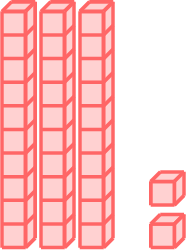 \(-\)
\(-\)  \(=\)
\(=\)
 \(-\)
\(-\)
Counting each cube individually would be quite cumbersome, especially with larger numbers. In such cases, column subtraction is a more efficient method.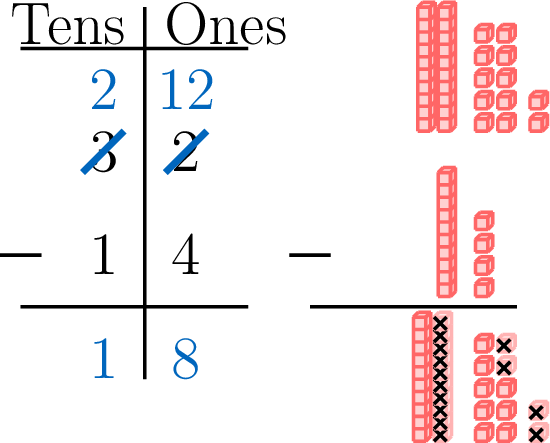
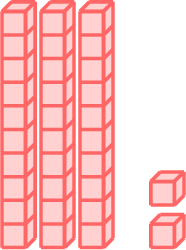 \(-\)
\(-\)  \(=\)
\(=\) 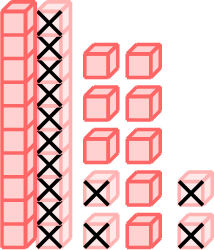

 \(-\)
\(-\) 
Definition Subtraction
Subtraction means taking something away. When we subtract, we find out how many are left.
- The \(-\) symbol means "subtract."
- The \(=\) symbol shows that the two sides are the same.
- Numbers: $$32 - 14 = 18$$
- Cubes:
 \(-\)
\(-\)  \(=\)
\(=\) 
- Words:
thirty-two minus fourteen equals eighteen - Part whole model:

Subtracting Ones Then Adding Tens
Method Subtracting Ones Then Tens Using Cubes
To calculate:\(37 - 14\)
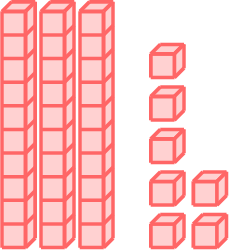 \(-\)
\(-\) 
 \(-\)
\(-\) - Step 1: Subtract the ones $$7 \text{ ones} - 4 \text{ ones} = 3 \text{ ones}$$
- Step 2: Subtract the tens $$3 \text{ tens} - 1 \text{ ten} = 2 \text{ tens}$$
- Result: There are 2 tens and 3 ones. So, $$37 - 14 = 23$$
 \(-\)
\(-\)  \(=\)
\(=\) 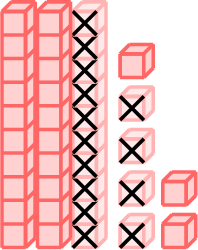
Let's work on \(32 - 14\). When we try to subtract the ones,$$2 \text{ ones} - 4 \text{ ones}$$ we don't have enough ones in \(32\). So, we’ll borrow 1 ten from the tens place and turn it into 10 ones. Now we have enough ones to finish the subtraction. Let’s see how it’s done!
Method Subtracting Ones Then Tens with Regrouping
To calculate:\(32 - 14\)
 \(-\)
\(-\) 
 \(-\)
\(-\) - Step 1: Subtract the ones with regrouping $$2 \text{ ones} - 4 \text{ ones}$$ We don’t have enough ones, so we borrow 1 ten from the tens place, turning it into 10 ones. Now we have \(12\) ones. $$12 \text{ ones} - 4 \text{ ones} = 8 \text{ ones}$$
 \(-\)
\(-\)  \(=\)
\(=\) 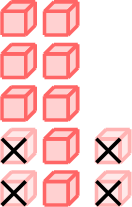
- Step 2: Subtract the tens $$3 \text{ tens of 32} - 1 \text{ ten of 14} - 1 \text{ ten of borrowing}= 1 \text{ ten}$$
- Result: There is 1 ten and 8 ones. So, $$32 - 14 = 18$$
 \(-\)
\(-\)  \(=\)
\(=\) 
Subtraction Using Columns
Method Subtraction in Columns
To calculate:$$37 - 14$$
- Step 1: Set up the subtraction
Write the numbers in a vertical column, making sure the digits line up by place value (ones under ones, tens under tens).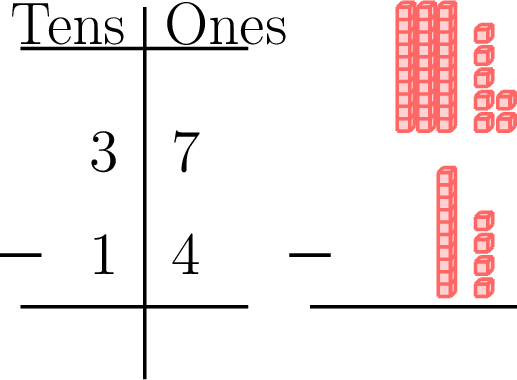
- Step 2: Subtract the ones $$7 \text{ ones} - 4 \text{ ones} = 3 \text{ ones}$$
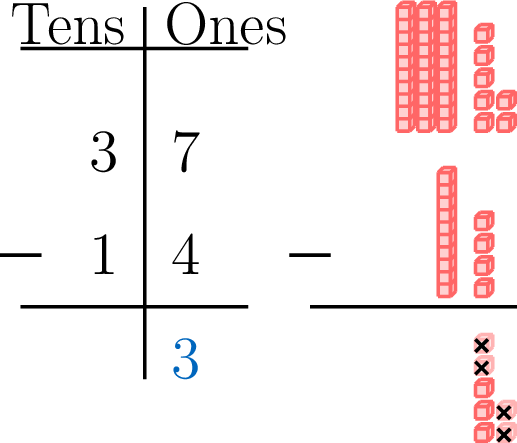
- Step 3: Subtract the tens $$3 \text{ tens} - 1 \text{ ten} = 2 \text{ tens}$$
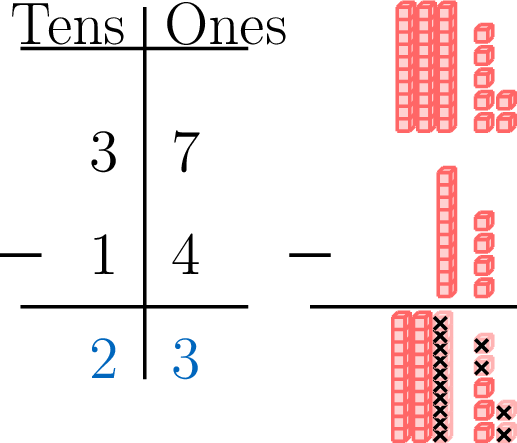
- Result: There are 2 tens and 3 ones. So,$$37 - 14 = 23$$
Method Column Subtraction with Borrowing
To calculate:\(32 - 14\)
- Step 1: Set up the subtraction
Write the numbers in a vertical column, making sure the digits line up by place value (ones under ones, tens under tens).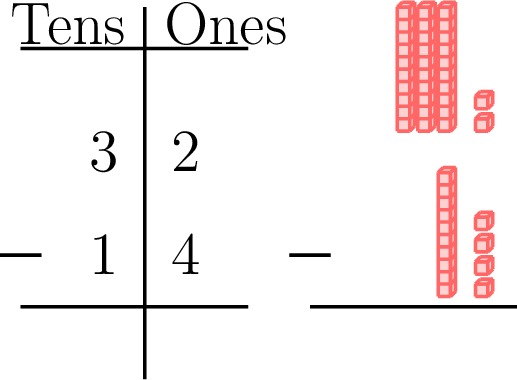
- Step 2: Regroup 1 Ten $$2 \text{ ones} - 4 \text{ ones}$$ We don’t have enough ones, so we borrow 1 ten from the tens place, turning it into 10 ones. Now we have \(12\) ones.
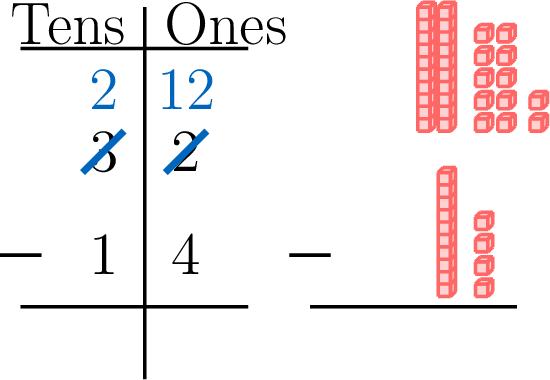
- Step 3: Subtract the ones $$12 \text{ ones} - 4 \text{ ones} = 8 \text{ ones}$$
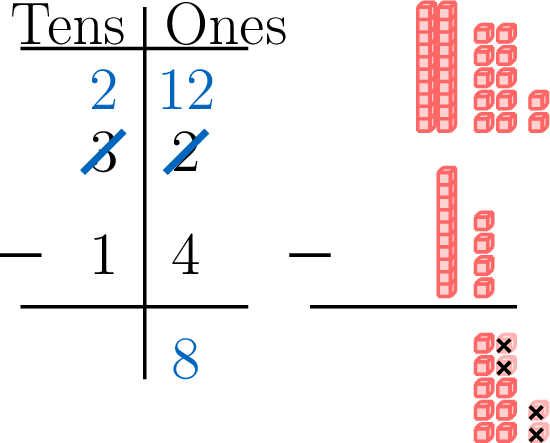
- Step 4: Subtract the tens $$3 \text{ tens (from 32)} - 1 \text{ ten (from 14)} - 1 \text{ ten (borrowed)} = 1 \text{ ten}$$

- Result: There is 1 ten and 8 ones. So, $$32 - 14 = 18$$